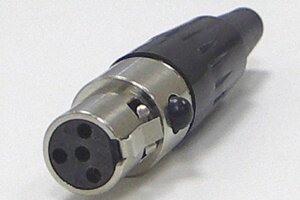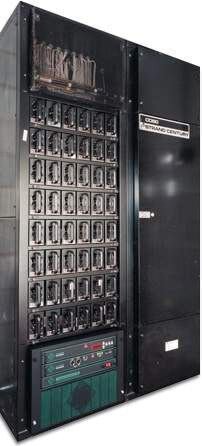Currently I am employed at a theatre that owns what I believe to be a none standard light board. The light board is atleast thirty years in age and was constructed by Strand Lighting. Instead of have a dmx output it has a four pin output. This is then plugged into a four pin wall outlet. Sadly they have an ETC Ion board sitting in their closet because the cannot plug the dmx into the wall. I do not know if the old light board runs on a whole different technology then dmx or just a no-standardize version of dmx. What must be down to see if this Ion can be used without purchasing a whole new dimmer system. Any help would be greatly appreciated.
You are using an out of date browser. It may not display this or other websites correctly.
You should upgrade or use an alternative browser.
You should upgrade or use an alternative browser.
Control/Dimming 4 Pin connector for old lighting board to work with five pin dmx?
- Thread starterCiv101
- Start date
The question is where does the end come out. I assume it plugs into the dimmers and operates something that is Strand specific. I am not a Strand guy so I can tell what it is but there are plenty here that can. What may be possible is to rewire the plug to be DMX compliant, then plug the other end through a converter to take the DMX back to the Strand protocol.To know for sure we need to know the board and dimmer type, make and model of both.
jstandfast
Active Member
It would appear that you've run across an unmodified Strand install from the 80's, using
their then standard AMX 192 control protocol. In order to make the Ion work you'll have aquire a protocol shifter to change the Ions DMX 512 output to the older, slower, less facile
AMX-192. The good news for you is that many are made and they're easy to find.
Now that I think of it, you'll likely have to adapt the output of your shifter(almost certain to be regular XLR-4) to that annoying TY-4 connector that's probably in your booth
wall. Best of luck...............
their then standard AMX 192 control protocol. In order to make the Ion work you'll have aquire a protocol shifter to change the Ions DMX 512 output to the older, slower, less facile
AMX-192. The good news for you is that many are made and they're easy to find.
Now that I think of it, you'll likely have to adapt the output of your shifter(almost certain to be regular XLR-4) to that annoying TY-4 connector that's probably in your booth
wall. Best of luck...............
Civ101, is this the connector?

Switchcraft TA4F
Are the dimmers Strand-Century CD80?

If yes to both, as others have said above, you need a DMX-to-AMX protocol converter to use the Ion with the existing dimmers. Or, the dimmers could be upgraded to take DMX512 directly. Let us know if you need further advice.

Switchcraft TA4F
Are the dimmers Strand-Century CD80?

If yes to both, as others have said above, you need a DMX-to-AMX protocol converter to use the Ion with the existing dimmers. Or, the dimmers could be upgraded to take DMX512 directly. Let us know if you need further advice.
Last edited:
waynehoskins
Active Member
Yep, that's most certainly old CD80 Protocol, which later became standardized as USITT AMX-192.
DMX-512 wasn't standardized until 1986, and in fact it was based on the existing Colortran Protocol. Prior to that, there were tons of manufacturer-specific protocols that made interoperability a royal pain.
A proto converter like a Pathway Ultimate Converter or an ETC Response AMX Converter should allow a modern DMX board to drive that dimming system.
Alternatively, there are rack electronics upgrades for many racks that will allow the rack to take in DMX. Johnson Systems comes to mind, and I believe Strand made some, though I don't think theirs were for original CD80s.
What board and rack does the space have? If the rack is a CD80, is it the newer Advanced Electronics CD80AE or original? It surely wouldn't be the Supervisor CD80SV from the '90s.
DMX-512 wasn't standardized until 1986, and in fact it was based on the existing Colortran Protocol. Prior to that, there were tons of manufacturer-specific protocols that made interoperability a royal pain.
A proto converter like a Pathway Ultimate Converter or an ETC Response AMX Converter should allow a modern DMX board to drive that dimming system.
Alternatively, there are rack electronics upgrades for many racks that will allow the rack to take in DMX. Johnson Systems comes to mind, and I believe Strand made some, though I don't think theirs were for original CD80s.
What board and rack does the space have? If the rack is a CD80, is it the newer Advanced Electronics CD80AE or original? It surely wouldn't be the Supervisor CD80SV from the '90s.
FatherMurphy
Active Member
waynehoskins
Active Member
The newest Strand upgrade, C-21, does go into original CD-80 racks - I just did one last week.
Good to know. Maybe it was JSI's that wouldn't go back to the original CD80. Or something like that. I think I remember hearing that one of the electronics upgrades only was AE and forward, or maybe was more difficult on an original, but I can't remember any more.
techieman33
Well-Known Member
If he has multiple racks upgrading the electronics can get very expensive, not to mention all of the new cables to run. A converter box is a much more economical solution. Doug Fleenor makes nice boxes as well.
If he has multiple racks upgrading the electronics can get very expensive, not to mention all of the new cables to run. A converter box is a much more economical solution. Doug Fleenor makes nice boxes as well.
However, you do get better cooling, more reliable and servacible gear, and a much more stable protocol.
Yes, it is an expense, but it is a worthwhile expense. CD-80 racks are going to be going a long time because of these upgrades.
FatherMurphy
Active Member
A converter box is a good solution only as long as the rack processors are behaving. Once the 30 year old electronics in the original version CD-80 processors start dieing, an upgrade is the only way to regain reliability.
jstandfast
Active Member
Yes, that thought crossed my mind yesterday- this system must have lots of down time or a lot of those ramp cards should have gone to the great field service center in the sky by now...........A converter box is a good solution only as long as the rack processors are behaving. Once the 30 year old electronics in the original version CD-80 processors start dieing, an upgrade is the only way to regain reliability.
DuckJordan
Touring IATSE Member
Civ101, is this the connector?
View attachment 4593
Switchcraft TA4F
Are the dimmers Strand-Century CD80?
View attachment 4594
If yes to both, as others have said above, you need a DMX-to-AMX protocol converter to use the Ion with the existing dimmers. Or, the dimmers could be upgraded to take DMX512 directly. Let us know if you need further advice.
I have seen the input for AMX on the wall be a regular 4-pin XLR connector. Not sure if the boards ever used XLR because a DMX->AMX converter was being used which did have XLR connections too.
waynehoskins
Active Member
By the time of the Lightboard/M (mid-80s) they had adopted the AMX standard 4-pin full-size XLR. However, in the early days of CD80 Protocol (original Light Palette lines, Mantrix, etc.) they used the Tiny-QG. I don't know why, but they did. The story goes that guys on the road would swap the TA4 with a regular A4, keeping the same pinning, and who knows what gender standards (CD80 standard used males on both ends of cables and females on panels, which doesn't make sense if you're on the road). When the AMX standard was drafted, the pinning changed, I think more logically for an A4 connector.
So if you have a full-size A4 connector on the wall, it's hard to tell if it's wired with original CD80 pinning or AMX pinning without opening it up.
Aren't standards great?
It won't work. you should just give that Ion to me. What time shall I stop by to pick up that piece of junk taking up all that precious closet space? I suppose I could suffer the drive just to help out a fellow MinnesotanCurrently I am employed at a theatre that owns what I believe to be a none standard light board. The light board is atleast thirty years in age and was constructed by Strand Lighting. Instead of have a dmx output it has a four pin output. This is then plugged into a four pin wall outlet. Sadly they have an ETC Ion board sitting in their closet because the cannot plug the dmx into the wall. I do not know if the old light board runs on a whole different technology then dmx or just a no-standardize version of dmx. What must be down to see if this Ion can be used without purchasing a whole new dimmer system. Any help would be greatly appreciated.
Ken Pogin
Production / Tour Manager
Minnesota Ballet
Similar threads
- Replies
- 7
- Views
- 636
- Replies
- 8
- Views
- 2K
- Replies
- 1
- Views
- 2K
Users who are viewing this thread
Total: 1 (members: 0, guests: 1)


